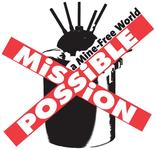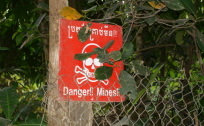Facts About Landmines
land mine n.
An explosive device laid usually just below the surface of the ground.
A land mine is an explosive device designed to be placed on or in the ground to explode when triggered by an operator or the proximity of a vehicle, person or animal. The name originates from the practice of sapping, where tunnels were dug (much like mining) under enemy fortifications or forces. These tunnels ("mines") were first collapsed to destroy fortifications above, and later filled with explosives and detonated.
Landmines generally refer to devices specifically manufactured for this purpose, as distinguished from improvised explosive devices (IEDs).
Landmines are explosive devices that are designed to explode when triggered by pressure or a tripwire. The purpose of mines when used by armed forces is to disable any person or vehicle that comes into contact with it by an explosion of fragments released at high speeds.
The exact number of landmines is unknown. However, it is estimated that millions of landmines and other unexploded ordnance (UXO) are buried in more than seventy six (76) countries and territories in all regions of the world.
Landmines can remain active more than fifty years after they are planted in the ground. For this reason, there is a continuing worldwide effort to rid the world of landmines.
"I want a world where every child has a chance to wear two shoes. When I buy shoes, I have to hide one shoe because the empty shoe reminds me of my missing leg and the horror of landmines."
- Song Kosal
Landmines
Landmine Survivors
The social and medical costs associated with landmines are astronomical. Landmines are found along roads, in fields and forests, beside power pylons, near wells and riverbanks, in homes and public buildings. As a result they can cause economic paralysis by restricting movement in what are usually agriculture-based economies.
Without landmines agricultural production could more than double in both Afghanistan and Cambodia. In Libya 27% of the total arable land is unusable due to mines left behind from World War Two, over 50 years ago.
Landmines are indiscriminate weapons by nature: they do not distinguish between a soldier's footstep and a child's footstep. Landmines maim and kill thousands of people every year, a third of which are children. Eighty percent of victims are civilians. Landmines impact every aspect of human life including the ability for refugees to return to their homes.
Humanitarian organizations and peacekeepers have raced against time to stabilize former war zones but instead have found themselves penned in and logistically paralyzed by millions of hidden killers. The terrible irony of modern day peacekeeping for United States troops is that their lives are sometimes threatened by landmines manufactured, sold and shipped out from their own nation a generation ago.
U.S. mines have been identified during clearance operations in old and new global hot spots like Rwanda, Lebanon, Iraq, Nicaragua, Laos, Vietnam, Cambodia, Mozambique, Somalia and Angola.
A landmine incident can cause various injuries to an individual including the loss of limbs, abdominal, chest and spinal injuries, blindness, deafness, severe burns, and less visible, psychological trauma not only to the person injured in the incident, but to the families of those killed or injured.
Children are particularly vulnerable to landmines in a number of ways. If they are too young to read or are illiterate, signs posted to warn them of the presence of mines are useless. Also, children are far more likely to die from their mine injuries than are adults. Of those maimed children who survive, few will receive prostheses that keep up with the continued growth of their stunted limbs.
The Mine Ban Treaty
The Convention on the Prohibition of the Use, Stockpiling, Production and Transfer of Anti-Personnel Mines and on Their Destruction, commonly referred to as the Mine Ban Treaty, was adopted on 18 September 1997 and entered into force on 1 March 1999.
The Mine Ban Treaty prohibits the use, stockpiling, production and transfer of antipersonnel mines. It is the most comprehensive international instrument for eradicating landmines and deals with everything from mine use, production and trade, to victim assistance, mine clearance and stockpile destruction.
There are currently 159 States Parties to the treaty and the treaty is still open for ratification by signatories and for accession by those that did not sign before March 1999.
States not party to the Mine Ban Treaty include: China, Egypt, Finland, India, Israel, Pakistan, Russia and the United States.
States Parties to the Mine Ban Treaty are obligated to:
Destroy their stockpile of antipersonnel mines within four years of entry into force (Article 4);
Make every effort to identify and clear mined areas under their jurisdiction or control as soon as possible, but not later than 10 years after becoming a State Party (Article 5);
Provide assistance to mine victims and support for mine risk education (Article 6); and
Submit annual reports on Mine Ban Treaty implementation activities (Article 7).
The treaty to ban landmines is a classic example of what can be achieved when non-governmental organizations (NGOs) and governments work together with determination to achieve a goal.
The International Campaign to Ban Landmines (ICBL) is a network of more than 1200 non-governmental organizations in over 60 countries, working for a global ban on landmines and cluster munitions.
Landmine Monitor Report 2011 reveals that the Mine Ban Treaty and the mine ban movement continue to make good progress toward eradicating antipersonnel landmines and saving lives and limbs in every region of the world. Significant challenges remain, however.
The International Campaign to Ban Landmines (ICBL) considers the Mine Ban Treaty the only viable comprehensive framework for achieving a mine-free world. The treaty and the global effort to eradicate antipersonnel mines have yielded impressive results. A new international norm is emerging, as many governments not party to the Mine Ban Treaty are taking steps consistent with the treaty, and an increasing number of non-state armed groups are also embracing a ban.
The United States is still the only NATO state not to have signed the treaty. Despite the dangers posed by antipersonnel mines to U.S. troops in combat and on peacekeeping missions, the Pentagon clings to its assumptions about the military benefits of the weapon. Armed with the knowledge of the danger and suffering that these killers inflict upon society, the boys in Washington still refuse to sign the Mine Ban Treaty.
Landmines stand guard long after the conflicts have ended and kill and maim without mercy or discrimination. As long as nations continue to use landmines, these devices will be a danger for civilians as well as soldiers.




